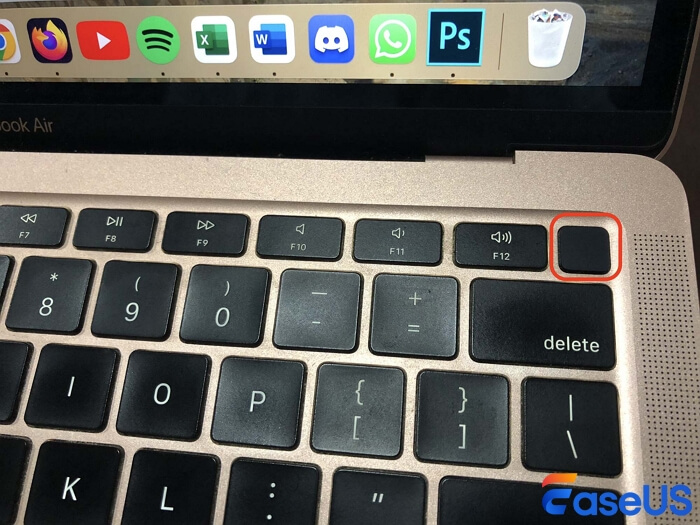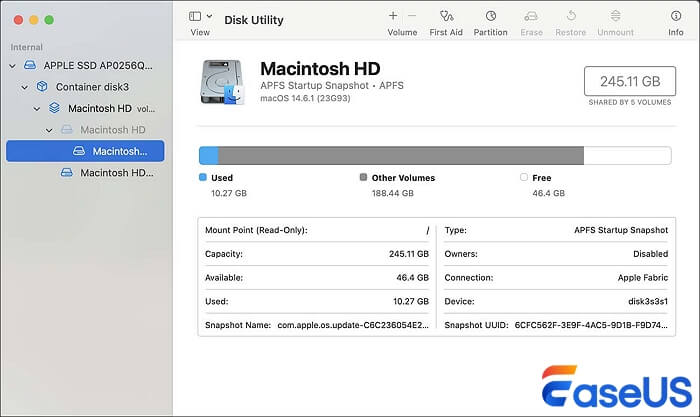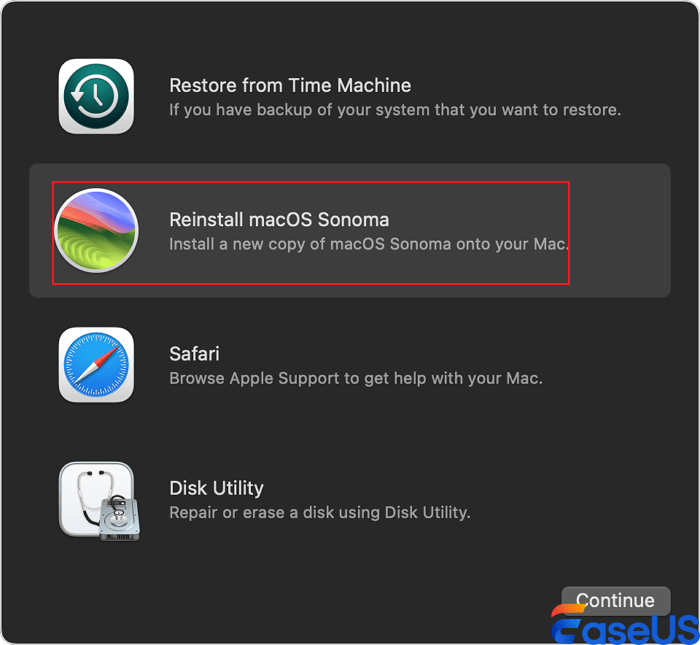Start Your Free Trial!
Sign up to our newsletter, stay updated on news and exclusive offers from EaseUS. Don't worry, if you change your mind, you can unsubscribe at any time, free of charge. We value your privacy (Privacy Policy).
The Mac grey screen of death is a typical problem many users experience when their systems fail to start correctly. This issue may occur when the system becomes stuck at the starting screen, which displays a grey or blank screen, occasionally accompanied by a spinning wheel or pointer. Users experience this problem for various reasons, including faulty startup disc files, hardware issues, and incorrect macOS upgrades.
Resolving the grey screen error is crucial for restoring access to your device and contents. Fortunately, various efficient ways exist to address this problem, ranging from easy remedies like removing external devices to more complex options such as performing First Aid or reinstalling macOS. In this lesson, we'll also examine how EaseUS Data Recovery Wizard for Mac may assist in recovering crucial data from unbootable computers so you don't lose essential information.
| Fix the Grey Screen of Death Mac | Step-by-step Troubleshooting |
|---|---|
| Recover Data from Gray Screen of Death Mac | When your Mac is stuck on the grey screen of death, you may be concerned about losing vital data,...Full steps |
| Method 1. Solve Mac Grey Screen of Death by Disconnecting External Devices | Hold the Power button for 3 - 5 seconds to power down your Mac. Unplug audio cords...Full steps |
| Method 2. Run First Aid in Recovery Mode to Fix Grey Screen of Death on Mac | Turn off your Mac by holding down the Power button. Press the Power button again and instantly hold ...Full steps |
| Method 3. Fix the MacBook Grey Screen by Resetting NVRAM/PRAM | Turn off your Mac by holding the "Power" button for 3 to 5 seconds. To start your Mac, press the...Full steps |
| Method 4. Reinstall macOS to Solve Mac Grey Screen of Death | Force shut down your Mac by holding the "Power" button for 3 to 5 seconds. After restarting your Mac...Full steps |
When your Mac is stuck on the grey screen of death, you may be concerned about losing vital data, particularly if it is unbootable. This is when the EaseUS Data Recovery Wizard for Mac is useful.
This dependable recovery program is intended to recover data from a MacBook that won't turn on, even if your device fails to boot because of a grey or blue screen of death. EaseUS can help you recover personal data, business papers, or valuable images, guaranteeing you don't lose anything crucial throughout the troubleshooting procedure.
EaseUS Data Recovery Wizard for Mac is especially useful when your Mac suffers system difficulties, crashes, the Mac won't turn on after updates, or the grey screen of death. It works even if you cannot reach the macOS desktop, enabling you to restore data from faulty startup discs or external media.
Check the following guide to recover data from your grey screen of death Mac:
Step 1. Launch EaseUS Software in Recovery Mode
Select "Utilities > Terminal" from the top menu, and enter the command sh <(curl https://d3.easeus.com/mac/boot.sh). Hit "Return". Wait for the application to open, and it will take several minutes.

Note: If the Terminal displays either "No such file or directory" or "Could not resolve host," you should verify that the command line you entered is correctly spelled, ensure your Mac has a stable internet connection, and confirm that your macOS version is not lower than macOS 10.15.
Step 2. Select the Volume on Your Mac Hard Drive
Select the volume where your lost data is stored, and click "Search for lost files". The EaseUS software will quickly locate all the recoverable data on the selected volume.

Step 3. Choose the Lost Data You Want
EaseUS software categorizes the scanned recoverable data by file type and storage path. Find the data you want by clicking "Type" or "Path" in the left panel. Then, check the boxes in front of the data you want to recover.

Step 4. Recover and Save Data on an External Disk
Click the "Recover" button, and a pop-up window will show up saying, "Please select a target location to save". Choose the external disk as the new storage location of your recovered data.

Start the EaseUS Data Recovery Wizard for Mac by following these steps. Please share this information on social media if it's helpful.
Faulty external devices or cables are a typical cause of Mac grey screen death. When a malfunctioning peripheral or cable disturbs the signaling pins on your Mac's ports, the system may freeze at startup. Disconnecting these devices may help address the problem. To troubleshoot, use these steps:
Step 1. Hold the Power button for 3 - 5 seconds to power down your Mac.

Step 2. Unplug audio cords, headphones, USB drives, Ethernet cables, and other accessories.
Step 3. To turn your Mac back on, press the Power button.
Step 4. Reconnect each peripheral individually if your Mac has successfully booted to the login screen. Restart the MacBook after attaching each device to determine which peripheral is malfunctioning.
Step 5. Once you've identified the faulty accessory, leave it unconnected and restart your Mac with the functional devices.
Isolating the malfunctioning device will repair the grey screen issue and avoid future difficulties.
Running First Aid in Recovery Mode may assist in correcting any disc issues that may be causing the Mac's grey screen of death. This program scans your Mac's internal disc for file system issues and automatically fixes them. Follow these steps to provide first aid:
Step 1. Turn off your Mac by holding down the Power button.
Step 2. Press the Power button again and instantly hold "Command + R" to enter Recovery Mode. Continue holding until the Apple logo shows.
Step 3. Once in Recovery Mode, pick "Disk Utility" from the choices and click "Continue."
Step 4. In Disk Utility, pick your starting disc from the sidebar (typically called "Macintosh HD").

Step 5. Click "First Aid" in the top toolbar, then "Run" to look for disk issues.
Step 6. After First Aid is completed, restart your Mac to check whether the grey screen problem has been repaired.
This technique helps repair probable disc issues, providing a simple but efficient solution to resolving the grey screen of death on your Mac.
Resetting your Mac's NVRAM and PRAM to their defaults may help fix the grey screen issue. NVRAM and PRAM hold critical information like display settings, time zones, and speaker volume. Corrupted settings might sometimes cause starting troubles, such as the grey screen of death. Follow these instructions to reset the NVRAM and PRAM:
Step 1. Turn off your Mac by holding the "Power" button for 3 to 5 seconds.
Step 2. To start your Mac, press the Power button and instantly hold down the "Option + Command + P + R" keys.

Step 3. Hold these keys until you hear the starting sound twice or see the Apple logo for the second time, then release them.
Step 4. Allow your Mac to complete the boot process, resetting the NVRAM and PRAM to their default defaults.
This easy reset may frequently resolve starting difficulties, such as the grey screen of death, by removing any damaged settings. You can share these solutions on social media to help more users!
If alternative solutions fail to cure the grey screen problem, reinstalling macOS may be required. This technique may replace corrupted system files, causing the grey screen issue. Follow these procedures to reinstall macOS:
Step 1. Force shut down your Mac by holding the "Power" button for 3 to 5 seconds.
Step 2. After restarting your Mac, press the "Command + R" keys to boot into macOS Recovery Mode.
Step 3. Once the "macOS Utilities" box opens, pick "Reinstall macOS" and click "Continue."

Step 4. Follow the on-screen directions to finish the macOS reinstallation on your storage drive.
Step 5. Once the installation is complete, restore any recovered data to your Mac.
Reinstalling macOS often addresses difficulties such as the grey screen of death, resulting in a new start with a clean system. Reinstalling macOS may cause data loss; you can apply EaseUS Data Recovery Wizard for Mac to recover missing files after macOS reinstallation.
The Mac grey screen of death is tough to fix, but solutions exist. We've covered unplugging external devices, running First Aid in recovery mode, resetting NVRAM/PRAM, and reinstalling macOS to fix this problem.
Data security is crucial throughout this process. EaseUS Data Recovery Wizard for Mac can recover deleted files from an unbootable Mac, ensuring no important data is lost during system repairs. If this information helps, share it on social media to aid others with Mac issues.
To solve Mac Grey Screen Error, have a look at these top searched FAQs:
1. Why does my Mac encounter a grey screen of death?
The Mac grey screen of death is usually caused by hardware or software difficulties. Poor peripherals, macOS startup files, disc faults, and NVRAM/PRAM difficulties are common culprits. Corrupt macOS upgrades or failed internal components might cause it.
2. How do I fix Mac's grey screen with the cursor?
To rule out hardware incompatibilities, unplug all external devices if your Mac has a grey screen with a cursor. You may boot into recovery mode and run First Aid with Disc Utility to check disc issues. Resetting NVRAM/PRAM or reinstalling macOS may fix it.
3. Why is My Mac grey screen of death after the update?
A grey screen after a macOS update usually suggests installation issues. Corrupt files, inadequate updates, or incompatibility may cause this. Reinstalling macOS in recovery mode or resetting NVRAM/PRAM may fix it.
Was This Page Helpful?
Dany is an editor of EaseUS who lives and works in Chengdu, China. She focuses on writing articles about data recovery on Mac devices and PCs. She is devoted to improving her writing skills and enriching her professional knowledge. Dany also enjoys reading detective novels in her spare time.
Related Articles
What Is M1 Mac Recovery Mode and How to Use It
![]() Jaden/2025-02-25
Jaden/2025-02-25
10 Fixes: Ghost of Tsushima DIRECTOR'S CUT Black Screen 💡
![]() Sherly/2025-02-25
Sherly/2025-02-25
Reinstall macOS Not Working: 4 Tested Ways to Fix It
![]() Brithny/2025-02-25
Brithny/2025-02-25
Copy Partition to Another Drive Using CMD: Quick & Efficient Ways
![]() Cici/2025-02-12
Cici/2025-02-12
EaseUS Data Recovery Services
EaseUS data recovery experts have uneaqualed expertise to repair disks/systems and salvage data from all devices like RAID, HDD, SSD, USB, etc.
CHOOSE YOUR REGION
Start Your Free Trial!
Sign up to our newsletter, stay updated on news and exclusive offers from EaseUS. Don't worry, if you change your mind, you can unsubscribe at any time, free of charge. We value your privacy (Privacy Policy).
Start Your Free Trial!
Sign up to our newsletter, stay updated on news and exclusive offers from EaseUS. Don't worry, if you change your mind, you can unsubscribe at any time, free of charge. We value your privacy (Privacy Policy).